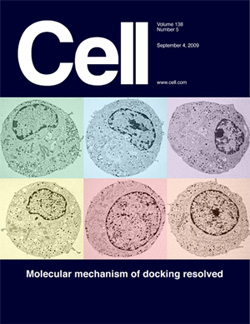
CNCR researchers Heidi de Wit and Matthijs Verhage have solved the previously unknown mechanism by which secretory vesicles dock at the target membrane in preparation for secretion. Together with their collaborators from Göttingen, Germany, they present a working model for docking in this month’s issue of Cell.
Intense studies on secretion have yielded detailed information about most steps in the secretory pathway, but for the most upstream steps, when vesicles first approach the target membrane and become stably associated with this membrane, a process referred to as ‘docking’, no consensus model existed yet. On the contrary, controversy over this issue accumulated of the recent years. Initially, it has been proposed that the same three proteins that drive fusion, the so called SNARE complex, are also responsible for docking. More recently it became clear that docking still occurred in situations where individual SNARE-proteins had been removed. Hence, it has been unclear how docking relates to setting up SNARE complexes and how docking connects to the subsequent priming and fusion steps in the secretory pathway.
CNCR researchers Heidi de Wit and Matthijs Verhage have now solved this issue together with their long term collaborators from Göttingen, Germany, the group of Jakob Sörensen at the Max Planck department of Erwin Neher. The researchers present a (minimal) working model for docking in this month’s issue of Cell (for link to article, please click here).
For their discoveries the researchers used chromaffin cells from the adrenal gland. In their past research, they realized that these cells are an excellent model system to unravel the principles of docking, since they produce most robust docking defects in electron micrographs upon null mutation of several candidate genes.
At the start of their current studies, the authors had already firmly implicated two proteins/genes in docking: the SNARE-protein syntaxin-1 and its binding partner Munc18-1. But the way these proteins account for docking and which protein(s) of the vesicle are involved were unknown. The researchers now show that the docking defects in chromaffin cells that lack Munc18-1 can be overcome (rescued) by two manipulations that promote the formation of an acceptor complex at the target membrane consisting of syntaxin-1 and a second SNARE-protein, SNAP-25. Hence, Munc18-1 itself may not be a docking protein, but an essential ‘supervisor’ of the formation of protein complexes that receive the approaching vesicles. While docking was rescued by these manipulations, secretion was not. This indicates that Munc18-1 probably has additional functions, downstream of docking. This was already hinted by previous studies in the same collaboration (Gulyás-Kovács et al. 2007, http://www.jneurosci.org/cgi/content/full/27/32/8676
To answer the question which protein(s) of the vesicle associated to the syntaxin-1/SNAP-25 acceptor complex, De Wit and colleagues considered several proteins present in the membrane of the vesicle and finally identified synaptotagmin-1 as the responsible molecule. Synaptotagmins as widely known as the Ca2+-sensors for secretion (which is triggered by Ca2+-influx) and are also known to promote fusion by interacting with membranes and changing their shape in order to fuse vesicle- and target membrane. The unexpected role of synaptotagmin-1 in the upstream docking step became clear in chromaffin cells where the synaptotagmin-1 gene was genetically inactivated. These cells had docking defects similarly strong as those lacking syntaxin-1, SNAP-25 or Munc18-1. In a large number of additional experiments, the researchers then generated specific mutations in SNAP-25 and synaptotagmin-1 that inhibit binding to each other. These mutant versions of the proteins were then expressed into chromaffin cells that lack expression of the natural gene using recombinant viruses. These experiments strengthened the conclusion that docking depends on the interaction between this vesicular and target membrane protein.
The data of this study together allow for the first time to draw a (minimal) model of the docking step and its relation to downstream steps that have previously been elucidated (see figure below).